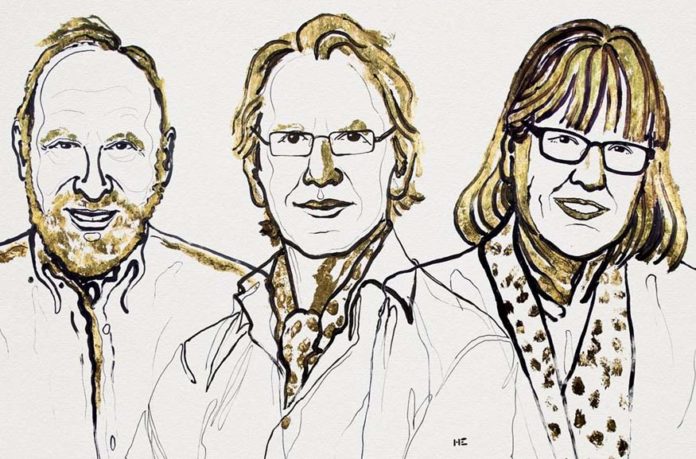Disclaimer: The Eqbal Ahmad Centre for Public Education (EACPE) encourages critical and independent thinking and believes in a free expression of one’s opinion. However, the views expressed in contributed articles are solely those of their respective authors and do not necessarily reflect the position or policy of the EACPE.
The Royal Swedish Academy of Sciences decided to award the Nobel Prize in Physics 2018 for groundbreaking inventions in the field of laser physics. According to a press release on October 2, 2018, Arthur Ashkin was awarded one half, Gerard Mourou and Donna Strickland both with one fourth, jointly shared the Nobel Prize, this year.
Arthur Ashkin, an American scientist, who worked at Bell Laboratories, US and Lucent Technologies, invented ‘optical tweezers’ and proposed their application on biological system. Gerard Mourou, a French scientist, introduced an efficient way of generating high-intensity, ultrashort optical pulses. Donna Strickland, a Canadian female optical scientist, made the most outstanding contribution on ‘chirped pulse amplification’. She became the first woman winner of Nobel Prize since Maria-Mayer in 1963 for her discoveries about the nuclear shell structure in nuclear physics.
These inventions by the Nobel Laureates, this year, have revolutionised several branches of science and engineering. The work also presents an insight about researchers and their significant control over the microscopic world.
Ashkin (96) developed optical tweezers while at Bell Lab in the 1970 and 1980. He used lasers to trap and control particles as small as individual atoms, which provides the best probing tool to study microscopic structures like DNA, viruses, bacteria and living cells. His key innovation is the discovery that a single laser beam can trap an object in three dimensions by pushing it downstream and back upstream at the same time. In the typical way the optical tweezers bring a beam of light into a sharp focus and a small object near the focal point can scatter some portion of light straight downstream (in the direction of laser beam). Consequently, the object recoils upstream (direction opposite to laser beam). This upstream force compensates for the normal downstream radiation pressure and forms a trap. Atoms trapped and cooled with the optical tweezers have been used to engineer highly precise atomic clocks and to measure acceleration due to gravity and study of Bose-Einstein condensates. Ashkin and other researchers have used optical tweezers to trap biological systems without damaging them. Experts say the ‘tweezer’ has become one of the basic tools and the primary weapon for a biophysicist.
He used lasers to trap and control particles as small as individual atoms, which provides the best probing tool to study microscopic structures like DNA, viruses, bacteria and living cells.
Gerard Mourou, Professor and member of the Haut-collège of École Polytechnique, and Donna Strickland, a professor at the University of Waterloo in Canada engineered a method of generating extremely short (few femtoseconds), but intense lasers pulses (10^15 watt), now known as ‘chirped pulse amplification’ (CPA) in scientific literature. The CPA technique has found applications in different branches of Physics, including Nuclear and Particle physics. However, experts adapted it to the medical field, which has led to improvement in refractive eye surgery and the treatment of contract (eye disease).
Strickland was a PhD student, while she worked with Mourou at the University of Rochester, where they discovered how to amplifying laser pulses in 1985. Here’s how they first stretched out a short pulse of laser light such that high-frequency component of the pulse lags the low-frequency component. This stretched, chirped pulse could then be amplified and recompressed. According to Strickland, “different people were trying to get short pulses amplified in different ways. It was thinking outside the box to stretch first and then amplify”.
Short pulse lasers have a variety of uses in Physics, Biology, Chemistry, industry and medicine. Matthias Kling, a laser physicist at Ludwig Maximilian university, Germany, said “in my view, chirped pulse amplification is as important as the invention of the laser itself”.
Originally published here.
 The writer, Irfan Khan, is a Researcher of Natural Sciences at Physics Department, Quaid-e-Azam University, Islamabad, Pakistan. He can be reached at ik8828903@gmail.com
The writer, Irfan Khan, is a Researcher of Natural Sciences at Physics Department, Quaid-e-Azam University, Islamabad, Pakistan. He can be reached at ik8828903@gmail.com



 The writer, Irfan Khan, is a Researcher of Natural Sciences at Physics Department, Quaid-e-Azam University, Islamabad, Pakistan. He can be reached at
The writer, Irfan Khan, is a Researcher of Natural Sciences at Physics Department, Quaid-e-Azam University, Islamabad, Pakistan. He can be reached at 




Congratulations for ground breaking inventions.
Congratulations for ground breaking inventions